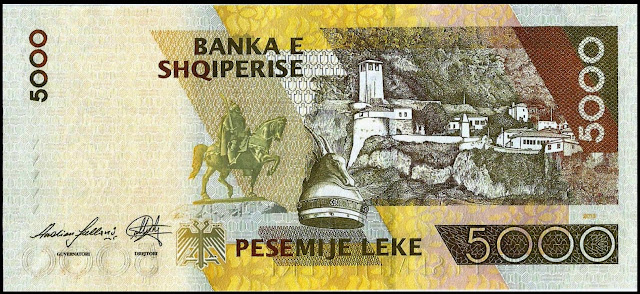Albania Banknotes 5000 Leke banknote 2012 Skanderbeg
Bank of Albania - Banka e Shqiperise
Obverse: Portrait of Gjergj Kastriot Skanderbeg, (1405-1468), a national hero - the most outstanding representative of the Albanian history, who led the Albanians against the Ottoman invaders. Other elements include the double-headed eagle, and Skanderbeg's shield and sword. (Portrait of Skanderbeg in the Uffizi, Florence, Italy)
Reverse: View of Kruja Castle, Skanderbeg's helmet (Skanderbeg's helmet preserved in the Kunsthistorisches Museum of Vienna) and equestrian statue of Skanderbeg in Tirana.
Watermark: Portrait of Gjergj Kastriot Skanderbeg.
Size: 160 mm x 72 mm
Colour: brown in yellow
Date first issued: 01.01.1999
The 5000 Lekë note, issued in 1996, was printed by "De La Rue". The note was reprinted by "Oberthure" banknote printing company in 2001 with improved security features and put in circulation (i.e. became legal tender) on 1 September 2004.
On 15 May 2009, the Bank of Albania put in circulation the 5000 Lekë note of legal tender, issue of 2007. It retains the same design and dimension as the 5000 Lekë note, issue of 2001. Security related and damage-resistant elements are improved or added to this banknote. Signatures of the Governor and Director of Issue Department as well as the year are updated.
Older 5000 Lekë notes shall continue to be legal tender and shall continue to be in circulation along with the new note, issued in 2007.
Albania banknotes - Albania paper money
1996-2012 Issue
Skanderbeg
George Kastrioti (Albanian: Gjergj Kastrioti; 1405 – 17 January 1468), commonly known as Skanderbeg (Albanian: Skënderbeu, from Turkish: İskender Bey, meaning "Lord Alexander"), was a 15th-century Albanian nobleman.
Skanderbeg was born in 1405 to the noble Kastrioti family. Sultan Murad II took him hostage in 1423 and he served the Ottoman Empire during the next twenty years. He was appointed as sanjakbey of the Sanjak of Dibra by the Ottomans in 1440. In 1443, he deserted the Ottomans during the Battle of Niš and became the ruler of Krujë, Svetigrad, and Modrič. In 1444, he was appointed as a commander of the short-lived League of Lezhë, which proclaimed him Chief of the League of the Albanian people. He was admired for defending the region of Albania against the Ottoman Empire for 25 years. In spite his military valor he was not able to do more than to hold his own possessions within the very small area in the North Albania where almost all his victories against the Ottomans took place. Skanderbeg's rebellion was not a general uprising of Albanians, due to the fact that he did not gain support in the Ottoman-controlled south of Albania or Venetian-controlled north of Albania. His followers, along with Albanians, included Slavs, Vlachs, and Greeks.
In 1451, he recognized de jure the suzerainty of the Kingdom of Naples through the Treaty of Gaeta, to ensure a protective alliance, although he remained a de facto independent ruler. In 1460–1461, he participated in Italy's civil wars in support of Ferdinand I of Naples. In 1463, he became the chief commander of the crusading forces of Pope Pius II, but the Pope died while the armies were still gathering. Together with Venetians he fought against the Ottomans during the Ottoman–Venetian War (1463 – 1479) until his death in January 1468.
Skanderbeg's military skills presented a major obstacle to Ottoman expansion, and he was considered by many in western Europe to be a model of Christian resistance against the Ottoman Muslims. Skanderbeg is Albania's most important national hero and a key figure of the Albanian National Awakening.

